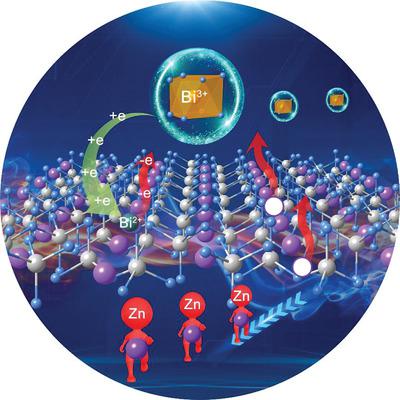当前位置:
X-MOL 学术
›
Laser Photonics Rev.
›
论文详情
Our official English website, www.x-mol.net, welcomes your feedback! (Note: you will need to create a separate account there.)
Anti‐Thermal‐Quenching Bi3+ Luminescence in a Cyan‐Emitting Ba2ZnGe2O7:Bi Phosphor Based on Zinc Vacancy
Laser & Photonics Reviews ( IF 11.0 ) Pub Date : 2020-11-03 , DOI: 10.1002/lpor.202000048 Yi Wei 1 , Hang Yang 1 , Zhiyu Gao 1 , Xiaohan Yun 1 , Gongcheng Xing 1 , Chenggang Zhou 1 , Guogang Li 1
Laser & Photonics Reviews ( IF 11.0 ) Pub Date : 2020-11-03 , DOI: 10.1002/lpor.202000048 Yi Wei 1 , Hang Yang 1 , Zhiyu Gao 1 , Xiaohan Yun 1 , Gongcheng Xing 1 , Chenggang Zhou 1 , Guogang Li 1
Affiliation

|
Thermal quenching (TQ) of phosphor is one of the biggest challenges to develop high‐quality white light‐emitting diodes (w‐LEDs). Herein, an anti‐thermal‐quenching (anti‐TQ) property in cyan‐emitting Ba2ZnGe2O7:Bi3+ phosphor is reported. At 150 °C, its emission intensity increases to 114% of the original intensity at 25 °C. Especially, the integrated emission intensity reaches 138%, 148%, and 134% at 150, 200, and 250 °C, respectively, by artificially creating zinc and oxygen vacancy defect. The anti‐TQ phenomenon is mainly attributed to high structure rigidity and strong ability to compensate emission loss during thermal generation process. Thermal‐induced emission compensation mainly stems from self‐oxidization behavior of Bi2+ in zinc vacancy and the presence of oxygen vacancy defect. Oxygen vacancy is induced by native zinc vacancy and charge imbalance between Bi3+ and Ba2+ ions. The strategy to create oxygen vacancy defect and design self‐oxidization process of Bi opens a new insight to exploit anti‐TQ phosphors for high‐quality w‐LEDs applications.
中文翻译:

基于锌空位的蓝绿色发光Ba2ZnGe2O7:Bi荧光粉的抗热猝灭Bi3 +发光。
磷光体的热淬灭(TQ)是开发高品质白色发光二极管(w -LED)的最大挑战之一。在此,发蓝光的Ba 2 ZnGe 2 O 7:Bi 3+中的抗热猝灭(anti-TQ)特性报告了磷光体。在150°C下,其发射强度增加到25°C下原始强度的114%。特别是,通过人为地造成锌和氧空位缺陷,在150、200和250°C时,综合发射强度分别达到138%,148%和134%。抗TQ现象主要归因于较高的结构刚度和强大的热生成过程中补偿排放损失的能力。热诱导的排放补偿主要源于Bi 2+在锌空位中的自氧化行为和氧空位缺陷的存在。天然的锌空位和Bi 3+与Ba 2+之间的电荷不平衡引起氧空位离子。Bi产生氧空位缺陷和设计自氧化过程的策略为利用抗TQ荧光粉用于高质量w - LED应用开辟了新的见解。
更新日期:2021-01-08
中文翻译:

基于锌空位的蓝绿色发光Ba2ZnGe2O7:Bi荧光粉的抗热猝灭Bi3 +发光。
磷光体的热淬灭(TQ)是开发高品质白色发光二极管(w -LED)的最大挑战之一。在此,发蓝光的Ba 2 ZnGe 2 O 7:Bi 3+中的抗热猝灭(anti-TQ)特性报告了磷光体。在150°C下,其发射强度增加到25°C下原始强度的114%。特别是,通过人为地造成锌和氧空位缺陷,在150、200和250°C时,综合发射强度分别达到138%,148%和134%。抗TQ现象主要归因于较高的结构刚度和强大的热生成过程中补偿排放损失的能力。热诱导的排放补偿主要源于Bi 2+在锌空位中的自氧化行为和氧空位缺陷的存在。天然的锌空位和Bi 3+与Ba 2+之间的电荷不平衡引起氧空位离子。Bi产生氧空位缺陷和设计自氧化过程的策略为利用抗TQ荧光粉用于高质量w - LED应用开辟了新的见解。



























 京公网安备 11010802027423号
京公网安备 11010802027423号